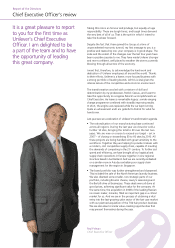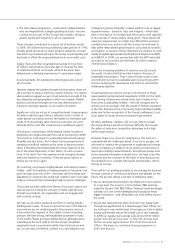Unilever 2008 Annual Report Download - page 19
Download and view the complete annual report
Please find page 19 of the 2008 Unilever annual report below. You can navigate through the pages in the report by either clicking on the pages listed below, or by using the keyword search tool below to find specific information within the annual report.
Report of the Directors
Environment and Vitality – Working towards sustainability
Unilever depends on the natural
environment for supplies of raw
materials and water. Sustainability
is a business issue.
39%
reduction
in CO2 from energy
1995-2008*
68%
reduction
in total waste
1995-2008*
Over two thirds of our raw materials come from agriculture.
Changing weather patterns, water scarcity and unsustainable
farming practices threaten the long-term viability of agricultural
production. Packaging depends on supplies of paper and other
materials. Water is essential for consumers when using many of
our brands.
For more than a decade we have been working to reduce the
environmental impact of our own operations. Now we are going
further to look at indirect impacts, encompassing suppliers and
consumers where possible. In 2008 we piloted a way to measure
our product categories against four indicators covering water,
waste, sustainable sourcing and greenhouse gas emissions.
This data will inform future development and innovation across
our categories.
Sourcing sustainably
Unilever buys approximately 12% of the world’s black tea, 7% of
the world’s tomatoes and 4% of its palm oil. We have developed
detailed guidelines on what sustainable agriculture means for key
crops, covering issues such as reducing pesticide use, conserving
water and using less energy.
In 2007 we announced our commitment to source all our tea
from certified sustainable sources. About half the Lipton Yellow
Label and PG tips we sell in Western Europe is now grown on
Rainforest Alliance Certified™ farms. This commitment was
instrumentalinwinningacontracttosupplyteaforMcDonald’s
in several European countries.
Hellmann’smayonnaiseiscommittedtosourcingcagefreeeggs
for all products sold in Western Europe by 2010.
Mostoftheworld’soilpalmisgrowninSEAsiawherethe
clearance and burning of forests contributes to global warming.
Worldwide, deforestation releases nearly 20% of the world’s
greenhouse gases. Working with Greenpeace, we have built a
global coalition of companies, banks and NGOs to break the
link between deforestation and the cultivation of oil palm.
In 2008, we announced our intention to have all our palm oil
certified as sustainable by 2015.
Addressing climate change
Changes in climatic conditions threaten the stability of the
markets where we operate, as well as our agricultural supply
chain. Developing countries, where we are growing strongly,
are especially vulnerable to the effects of climate change.
We are committed to reducing carbon dioxide emissions from
energy in our manufacturing operations by 25% by 2012
(measured by tonne of production against a baseline of 2004).
Since 1995 we have achieved a 39% reduction in CO2 from
energy per tonne of production. In 2008 we reduced our CO2
emissions by 1.6% per tonne of production compared to 2007*.
In fact most CO2 emissions associated with our brands occur
during consumer use since many of our products require energy
to heat water for cooking and washing. Through the design and
formulation of our products, we can make a difference. For
example, by developing concentrated detergents that use fewer
raw materials and less packaging, that are less energy intensive to
manufacture, and that are effective at lower wash temperatures.
Conserving water
Our brands rely on water at each stage of their life cycle –
upstream in the supply chain, in our own manufacturing
operations and in the hands of consumers.
Since 1995 we have reduced the amount of water we use per
tonne of production by 63% by minimising water use and
maximising water recycling. During 2008 we achieved a
3% reduction in water use compared to 2007 from 3.05m3
to 2.96m3 per tonne of production*.
The most direct impact we can have on water conservation
is by designing products that use less. Surf Excel Quick Wash
laundry detergent, for example, saves two buckets of water
per wash for consumers in India – a real benefit when water is
scarce and costly. In 2008 sales increased by 20%. One Rinse
Comfort fabric conditioner eliminates the need to rinse clothes
before applying the conditioner.
6 3 %
reduction in water
1 9 9 5 - 2 0 0 8 *
*Measuredbytonneofproduction.2008dataispreliminary.Itwillbeindependently
assured and reported in our online Sustainable Development Report 2008 at
www.unilever.com/sustainability
16 Unilever Annual Report and Accounts 2008
























